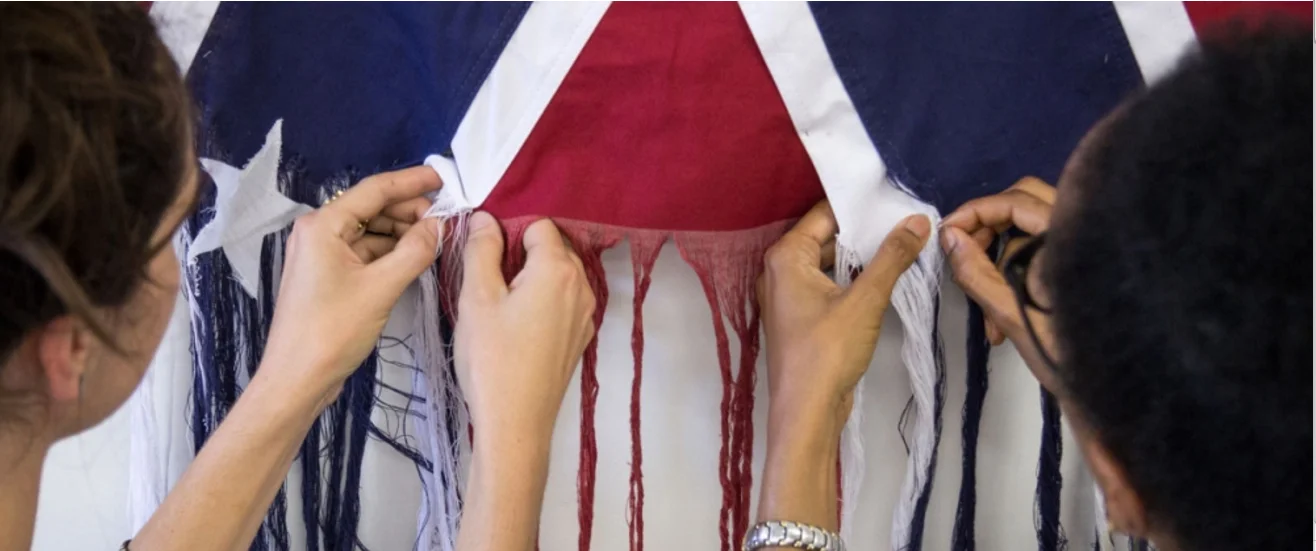Sonya Clark's "Unraveling"
An installment of my regular column "Letter from America" in Crafts Magazine, January/February 2018.
“What’s curious to me is that someone will say I’m being courageous. And I tell them: you’re standing right here next to me. We are being courageous.” That is Sonya Clark, describing the experience of staging her performance work Unraveling.
The work could not be simpler, nor more resonant given the current state of the USA. Back in 2015, marking the 150th anniversary of the end of the Civil War, Clark hung a Confederate battle flag from a gallery wall. She invited members of the public to stand with her, shoulder to shoulder, and unpick it together, thread by thread. She has since enacted the performance several times, most recently at the Speed Art Museum in Louisvillle.
Sonya Clark and a visitor unpicking the flag. Unraveling, Sonya Clark, 2015, Cotton Confederate Flag. Photo: Courtesy The Artist. Photo Taylor Dabney
Sonya Clark, Unraveling, 2015. Cotton Confederate Flag. Photo: Courtesy The Artist. Photo Taylor Dabney
When Clark first staged Unraveling, three years ago, she does not remember anyone telling her how “brave” she was. But today, with an avowed racist in the Oval Office and white supremacists everywhere gaining confidence, things are different. For an African-American woman to undertake this act, even in the comparative safety of Louisville’s Speed Art Museum, does feel like a bodily risk. Yet the audacity of the work is not just physical. It is also emotional for all concerned. Clark has had participants open up to her about their relatives in the KKK, for example. They often want her to know, “that’s not me.” She has also witnessed parents explain to their African-American children what the flag means, before they unwork it together.
Flags are indeed potent things, and remain so in our internet age. The rainbow flag of the gay rights movement; the EU’s circle of stars on a field of blue; St; George’s Cross, with its connotations of resurgent English nationalism; or the new Refugee Nation Flag, designed by Yara Said: though only made of cloth, we seem to need these symbols in order to think through our turbulent times.
They are also remarkably tenacious. A Confederate memorial that stood in Louisville was recently taken down by order of the mayor. Overnight, a supposedly permanent monument disappeared. A flag cannot be so easily gotten rid of. Anyone can make one, and anyway, we carry it round in our heads all the time. Yet, as Clark points out, there is nothing inevitable about the battle flag’s power. It is just one fragment taken from a complex history.
There is another flag, to which she has directed attention by remaking (rather than unmaking) it: the Confederate Flag of Truce, a field of white interrupted only by a few red stripes. The original (a small piece of cloth, probably made from a dishtowel) was present at Appomattox Court House in 1865 at the end of the Civil War. At some point after the peace treaty was signed, the flag was cut into pieces, which are today kept as relics in various museums.
That hardly anyone remembers the Flag of Truce, while the battle flag remains so present in our thoughts, is itself an indication of a troubled history. “The flag that brought our nation together was dismantled and forgotten,” Clark says, “while the flag that drove us apart is in all our imaginations.”
Could Americans collectively choose to embrace another, better history, the one where we meet and decide not to fight? The Flag of Truce looks not unlike a white handkerchief, with which one might signal surrender. That is a difficult thing to embrace. But it represents a choice Americans still have, and aren’t currently taking. Will we continue take up arms against one another – both rhetorically and in reality – or will we have the courage to lay them down?

